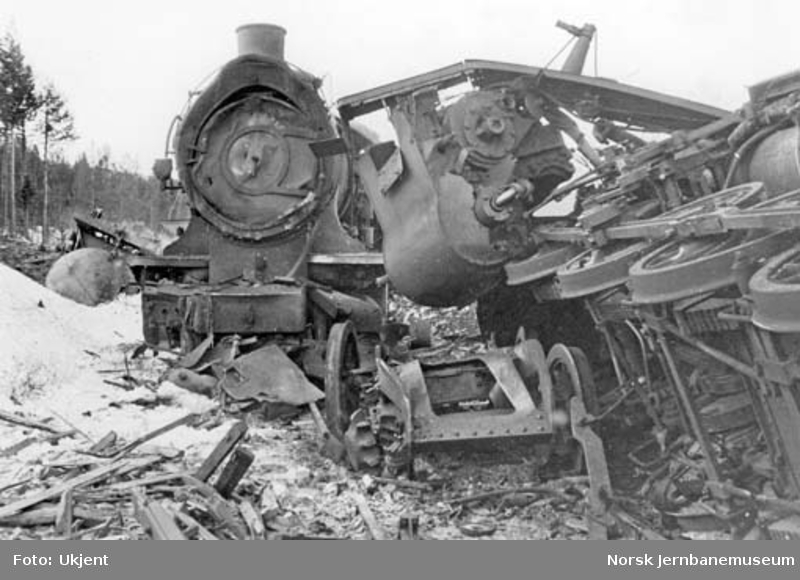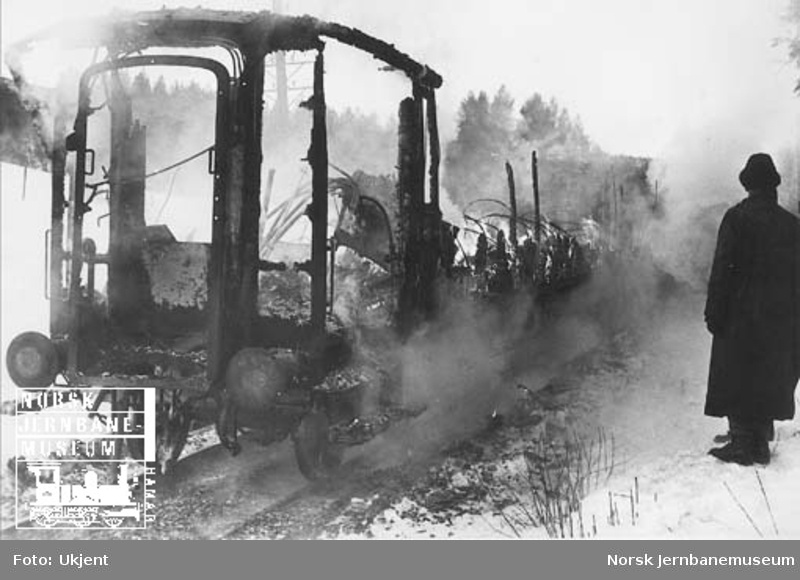Sometimes it happens that train brakes are failing, and the train driver loses control of the train. Such incidents are called “Runaway Train”. A runaway train may cause severe disasters. On Monday February 28th 1944 a severe railway disaster happened at Breifoss on the Bergen railway line. The night train from Oslo to Bergen collided with a runaway freight train at Breifoss near Geilo. At least 25 Norwegian civilians and an unknown number of German soldiers were killed.
 |
| Photo: Trygve Johannessen |
During the Second World War Norway was occupied by Nazi Germany. the German Wehrmacht had enormous needs for transportation, and all transports for Wehrmacht had the first priority. Many of these trains were overloaded. The war resulted in a serious lack of coal. Spare parts, proper lubrication oils and other consumables were difficult to obtain.
The second World War was a very difficult time for the Norwegian State Railways. In 1944 it had become more and more difficult to maintain passenger services for Norwegian civilians. From 1942 all passengers traveling more than 30 km had to hold a travel permit issued by their local police to be able to buy tickets for the journey. In 1944 it had become very difficult to get travel permits, and in the end of that year travel permits were not even issued for traveling to weddings or funerals.
Originally Oslo East Station was the terminus for the trains between Oslo and Bergen. At this time the trains were hauled by steam locomotives on non-electrified lines, and the railway line between Oslo East and Hønefoss via Roa was not electrified yet. During the war there was a serious lack of coal. By diverting the Bergen trains via Drammen to Oslo West the trains could be hauled by electric locomotives between Oslo West and Hokksund, and tons of coal were saved.
 |
| Unknown photographer |
At 19.00 on Sunday February 27th 1944 the night train No. 607 departed from Oslo West Station. From Hokksund the train was hauled by a steam locomotive. At the same evening an extra freight train departed from Bergen towards Oslo. The two trains were scheduled to cross at Geilo at 3.10. The night was very cold. The temperature at Finse was -29 degrees C. The freight train passed Finse station on time. When driving downhill towards Ustaoset the driver applied the brakes. The freight train had 15 tank wagons containing gasoline and oil. As common practise at that time the freight train had a guard’s van, and a conductor was in the van.
 |
| Unknown photographer, the Norwegian Railway Museum |
When the freight train passed Ustaoset Station the brakes failed. The driver gave warning signals with the steam whistle, and the guard climbed on the wagons and attempting to apply the hand brakes. This was not enough to avoid the collision. The freight train passed Geilo at high speed. An attempt was made to make the freight train derailing before it hit the night train. This attempt failed and the freight train collided with the night train at Breifoss. Both the driver and the stoker on the night train’s locomotive were killed instantly. The tank wagons were destroyed, and the gasoline caught fire. Some of the passenger coaches also caught fire. At least 25 Norwegian civilians and an unknown number of German soldiers were killed. The driver and the stoker on the freight train jamp off the locomotive before the collision, and were not injured. They were examined by the German police. Unfortunately they were suspected for sabotage, and sent to Grini concentration camp. The railway line was closed for three days.
The disaster was caused by brake failure on the freight train. This may have been a result of the poor quality of the oil used for lubrication of the brake valves and the very low temperature that night. These two factors may have caused the brake valves fail to respond, but this is not proven. An other factor may have been lack of proper maintenance. Spare parts were difficult to provide. During the war there was also lack of proper inspections and maintenance on the rolling stock. Some of the freight wagons were fitted with Kunze-Knorr brakes, and these brakes were not suitable for driving long downhill slopes.
Very little was written about the disaster in Norwegian newspapers. Norwegian press was under strict press censorship. Bergens Tidende, the biggest Bergen newspaper, wrote that no German soldiers had been injured. The reality was quite different. Many German soldiers were killed. The exact number of killed soldiers and many other aspects concerning the Breifoss disaster remain a mystery to this day.



No comments:
Post a Comment